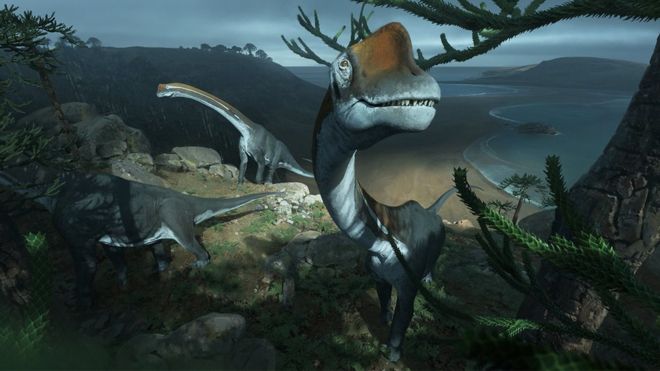The fossil of a dinosaur that has been languishing in a museum for decades has been re-examined – and it turns out to be that of a new species. According to BBC
Brachiosaurus, depicted in Jurassic Park, now has an early relative, providing clues to the evolution of some of the biggest creatures on Earth.
Scientists say the plant-eating dinosaur was longer than a double-decker bus and weighed 15,000kg.
Its remains were found in the 1930s.
Since then it has been somewhat over-looked, spending most of that time in storage crates.
Lead researcher Dr Philip Mannion said the dinosaur would have eaten all kinds of vegetation, such as ferns and conifers, and lived at a time when Europe was a series of islands.
”We don’t know what this creature died from, but millions of years later it is providing important evidence to help us understand in more detail the evolution of brachiosaurid sauropods and a much bigger group of dinosaurs that they belonged to, called titanosauriforms,” he said.
Asteroid strike
Titanosauriforms were some of the largest creatures ever to have lived on land and were very diverse, surviving right up until the asteroid strike that wiped out most life on Earth.
The new species, given the scientific name, Vouivria damparisensis, lived in the Late Jurassic, some 160 million years ago.
“It’s the earliest member of a group that includes Brachiosaurus – one of the most famous dinosaurs we know – one of the prominent animals in Jurassic Park,” Dr Mannion said.
“And it gives us a much clearer idea of what’s going on in the early evolution of this really important radiation of dinosaurs.”
Sauropods
The dinosaur is a sauropod – a sub-group of titanosauriforms, which include well-known groups such as Brachiosaurus, Diplodocus and Brontosaurus.
They had very long necks, long tails, and small heads with thick, pillar-like legs
The fossil predates the previously oldest-known member of this group by about five million years.
“It starts to give us an idea that these animals were evolving much earlier than the fossil record previously has indicated,” Dr Mannion added.
“This pushes back a lot of origin times for a range of sauropod dinosaurs based on our understanding of how these different species related to one another.”
The re-classification of Vouivria as an early member of the titanosauriforms will help in mapping their spread across the Earth, from Jurassic times to the extinction of all dinosaurs.
The fossil was discovered in 1934.
It was documented scientifically in the 1940s, but has not been studied in detail since then.
Its scientific name, Vouivria damparisensis, relates to ‘La vouivre’, a local folklore legend about a winged serpent.
N.H.Kh

